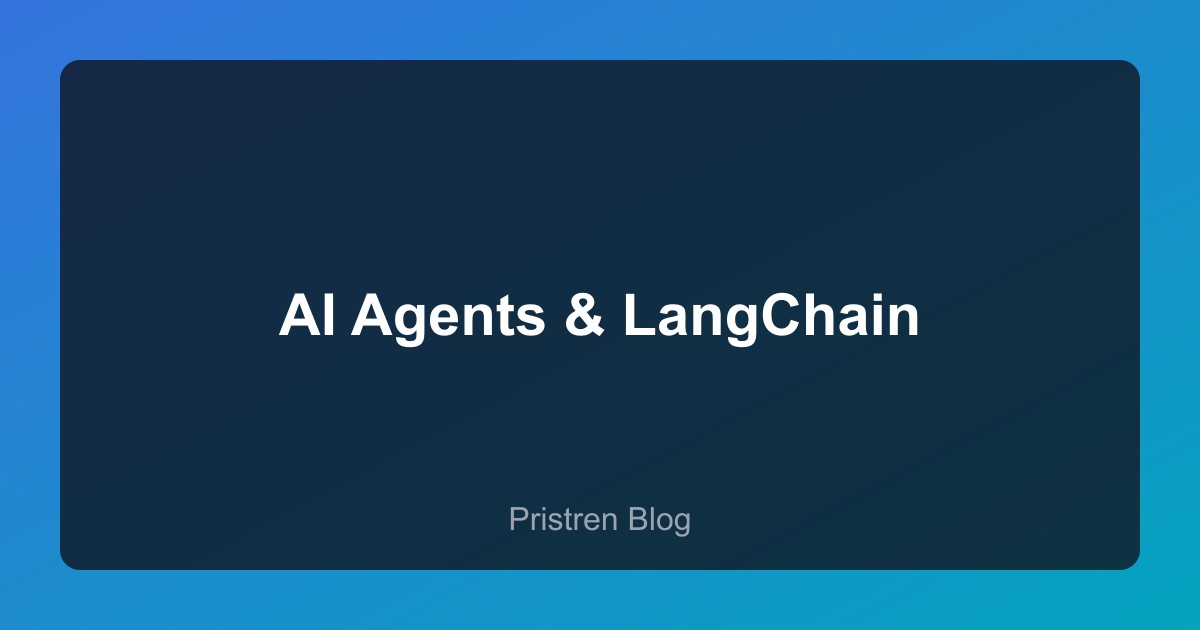AI agents represent the next evolution in artificial intelligence applications. Unlike simple chatbots, AI agents can autonomously plan, reason, and execute complex tasks by leveraging large language models (LLMs) as their cognitive engine.
AI Agent Architecture with LangChain
What Are AI Agents?
AI agents are autonomous systems that can:
- Perceive their environment through various inputs
- Make decisions based on goals and constraints
- Take actions to achieve objectives
- Learn and adapt from feedback
Building Blocks of Modern AI Agents
1. Large Language Models (LLMs) GPT-4, Claude, or other advanced LLMs serve as the "brain" of the agent, providing reasoning and language understanding capabilities.
2. LangChain Framework LangChain provides the orchestration layer that connects LLMs with tools, memory, and external data sources.
3. Tools and APIs Agents need access to external tools:
- Search engines for information retrieval
- Calculators for mathematical operations
- APIs for interacting with external services
- Code interpreters for executing programs
4. Memory Systems Agents require both short-term (conversation history) and long-term (vector databases) memory to maintain context and learn from interactions.
Architecture Patterns
ReAct Pattern (Reasoning + Acting)
The ReAct pattern alternates between reasoning about what to do and taking actions:
from langchain.agents import initialize_agent, Tool
from langchain.llms import OpenAI
# Define tools
tools = [
Tool(name="Search", func=search_function),
Tool(name="Calculator", func=calculate),
]
# Initialize agent
agent = initialize_agent(
tools=tools,
llm=OpenAI(temperature=0),
agent="zero-shot-react-description",
verbose=True
)
# Execute task
agent.run("What's the weather in Tokyo and convert the temperature to Fahrenheit?")
Plan-and-Execute Pattern
This pattern separates planning from execution:
- Planning: Create a high-level plan for achieving the goal
- Execution: Execute each step of the plan
- Reflection: Evaluate results and adjust if needed
Advanced Techniques
Multi-Agent Systems Multiple specialized agents collaborate to solve complex problems:
- Research agent: Gathers information
- Analysis agent: Processes and analyzes data
- Writing agent: Generates final output
Retrieval-Augmented Generation (RAG) Enhance agents with domain-specific knowledge by integrating vector databases:
from langchain.vectorstores import Chroma
from langchain.embeddings import OpenAIEmbeddings
# Create knowledge base
vectorstore = Chroma.from_documents(
documents=docs,
embedding=OpenAIEmbeddings()
)
# Agent with RAG
agent_with_rag = create_retrieval_agent(
llm=llm,
retriever=vectorstore.as_retriever(),
tools=tools
)
Tool Learning Agents can learn to use new tools dynamically through few-shot examples and documentation.
Real-World Applications
- Customer Support Agents: Handle inquiries, access databases, process refunds
- Research Assistants: Gather information, analyze data, generate reports
- Code Generation Agents: Understand requirements, write code, debug errors
- Personal Assistants: Manage calendars, send emails, book appointments
Challenges and Solutions
Challenge: Hallucinations and unreliable outputs Solution: Implement verification steps, use structured outputs, add human-in-the-loop
Challenge: Cost management with LLM API calls Solution: Cache responses, use smaller models for simple tasks, implement rate limiting
Challenge: Security and prompt injection Solution: Sanitize inputs, implement permission systems, audit agent actions
Best Practices
- Start Simple: Begin with single-purpose agents before building complex systems
- Monitor Performance: Track success rates, costs, and response times
- Implement Guardrails: Set boundaries on agent actions and resource usage
- Version Control: Track prompt templates and agent configurations
- Testing: Create comprehensive test suites for agent behaviors
The Future of AI Agents
The field is rapidly evolving with developments in:
- AutoGPT and BabyAGI: Fully autonomous agent frameworks
- Multi-modal Agents: Processing text, images, and audio
- Embodied AI: Robots and physical agents
- Agent-to-Agent Communication: Collaborative agent networks
Conclusion
Building AI agents with LangChain and GPT-4 opens up incredible possibilities for automation and intelligent assistance. As LLMs become more capable and frameworks more sophisticated, we'll see AI agents handling increasingly complex real-world tasks.
The key to success is starting with well-defined use cases, implementing proper safeguards, and continuously iterating based on real-world performance.

